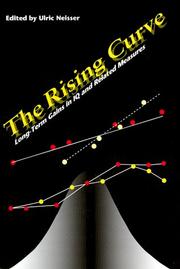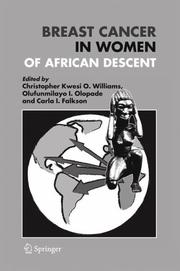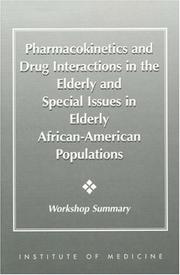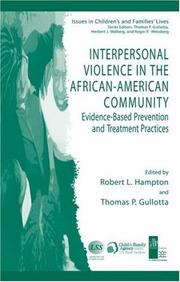| Listing 1 - 10 of 20 | << page >> |
Sort by
|
Periodical
Publisher: [Atlanta, Ga.] : American Cancer Society
Abstract | Keywords | Export | Availability | Bookmark
 Loading...
Loading...Choose an application
- Reference Manager
- EndNote
- RefWorks (Direct export to RefWorks)
African Americans --- Cancer --- Cancer. --- Neoplasms --- Neoplasmas --- African Continental Ancestry Group. --- African Americans. --- Neoplasms. --- Diseases --- Diseases. --- United States. --- Black People.

ISBN: 0394467604 9780394467603 Year: 1972 Publisher: New York (N.Y.): Random House
Abstract | Keywords | Export | Availability | Bookmark
 Loading...
Loading...Choose an application
- Reference Manager
- EndNote
- RefWorks (Direct export to RefWorks)
Black English --- African Americans --- Americanisms --- Languages --- African Continental Ancestry Group. --- Linguistics. --- -Black English --- African American English --- American black dialect --- Ebonics --- Negro-English dialects --- English language --- Afro-Americans --- Black Americans --- Colored people (United States) --- Negroes --- Africans --- Ethnology --- Blacks --- Linguistic --- Negro --- Negroid Race --- Negroid Races --- Race, Negroid --- Races, Negroid --- Provincialisms --- Dialects --- African Continental Ancestry Group --- Linguistics --- Black Person --- Black Peoples --- Black Persons --- People, Black --- Person, Black --- Persons, Black --- African Americans - Languages --- BLACK ENGLISH (LANGUE) --- NOIRS AMERICAINS --- AMERICANISMES --- ETATS-UNIS --- LANGUES
Book
ISBN: 2707199451 2707199443 Year: 2017 Publisher: Paris (9bis, rue Abel Hovelacque 75013) : La Découverte,
Abstract | Keywords | Export | Availability | Bookmark
 Loading...
Loading...Choose an application
- Reference Manager
- EndNote
- RefWorks (Direct export to RefWorks)
Pourquoi et comment l'infection VIH percute-t-elle la vie des immigrés d'Afrique subsaharienne en France ? Première étude quantitative d'ampleur menée par des chercheurs et des associations au sein de cette population particulièrement touchée par le virus, l'enquête ANRS Parcours a retracé en 2012-2013 les trajectoires migratoires, sociales, administratives et de santé de ces immigrés. Elle met en relief les difficultés d'installation, les bouleversements familiaux et professionnels à l'arrivée en France, et leurs conséquences en termes de santé. Plus qu'une recherche en santé publique, Parcours est une étude sur l'immigration en provenance de cette région du monde, une immigration marquée par des années de fragilité administrative et d'insécurité au quotidien. Elle met au jour les facteurs structurels qui pèsent, souvent de façon durable, sur l'installation des immigrés en France et accroissent leurs risques d'être infectés par le VIH une fois sur place. Elle montre aussi l'importance des dispositifs qui mettent en œuvre le principe d'universalité de l'accès aux soins (AME, PASS, associations humanitaires) et la nécessité de les garantir. Car la lutte contre le sida, véritable maladie de la précarité, passe par la réduction des inégalités de santé. Cette recherche a été conduite sous la responsabilité scientifique d'Annabel Desgrées du Loû (IRD), France Lert, Rosemary Dray-Spira et Nathalie Bajos (Inserm) et Nathalie Lydié (Santé publique France). Elle a été financée par l'Agence nationale de la recherche sur le sida et les hépatites virales (ANRS), avec le soutien de la Direction générale de la santé et de l'agence Santé publique France.
Africa, Sub-Saharan --- France --- Africa South of the Sahara --- France. --- Emigration and immigration. --- ethnology. --- Africans --- Immigrants --- Public health --- Health services accessibility --- HIV-positive persons --- Hepatitis B --- HIV Infections --- African Continental Ancestry Group. --- Emigrants and Immigrants. --- Health Services Accessibility. --- Social Conditions. --- Health and hygiene
Periodical
ISSN: 2271197X Year: 1947 Publisher: Paris : Editions du Seuil
Abstract | Keywords | Export | Availability | Bookmark
 Loading...
Loading...Choose an application
- Reference Manager
- EndNote
- RefWorks (Direct export to RefWorks)
C’est en décembre 1947 que le premier numéro de la revue Présence africaine voit le jour. Il couronne le rêve de son fondateur, Alioune Diop (1910-1980), qui l’avait déjà imaginé dès la fin de seconde guerre mondiale. Sur le plan historique, la revue suit les traces de celles qui ont été créées dès la fin de la première guerre par des Africains, les Noirs américains et les Antillais, Le Cri de Nègres, La Revue du Monde noir (1931), Légitime défense (1932, un seul numéro), L’étudiant noir (1934-1940), Tropiques (cofondée par Aimé Césaire et René Ménil). Elle se distingue cependant de toutes celles-ci parce qu’elle veut réunir et donner à entendre toutes les voix des Noirs du monde qui vivent tous sans exception, quelle que soit leur langue d’expression, une même expérience historique de la dépossession, du déni d’identité, de la souffrance due à l’esclavage et à la colonisation. Pour faire entendre cette voix et faire mesurer l’intensité et la réalité de cette présence des Nègres au monde, Alioune Diop fait appel, pour le premier numéro, a de prestigieux parrains parmi lesquels André Gide, Jean-Paul Sartre, Théodore Monod, Emmanuel Mounier, Albert Camus, Michel Leiris. Ceux-ci côtoient de prestigieux intellectuels noirs parmi lesquels, L. S. Senghor, Aimé Césaire et Richard Wright. En faisant figurer côte à côte des intellectuels européens et non européens dès le premier numéro de sa revue, Alioune Diop voulait déplacer le débat de la rencontre des peuples et des civilisations qui agitaient les revues précédentes sur le strict terrain de la pensée et de la culture. André Gide ne s’était pas trompé lorsqu’il écrivait en conclusion de son avant-propos du premier numéro : « Présence africaine se propose un vaste programme : accueillir tout ce qui a trait à la cause des Noirs, et toute voix du peuple noir qui lui paraisse mériter d’être entendue. » De fait, plus précisément, la revue avait choisi une ligne éditoriale de laquelle elle n’allait pas dévier : – faire connaître une pensée africaine englobant à la fois la philosophie et les sciences humaines ; – promouvoir les littératures africaines et leur critique. Cette ambition critique éloignait la revue de toute visée politique au mauvais sens du mot. Dans son liminaire « Niam n’goura ou les raisons d’être de Présence Africaine », Alioune Diop précisait d’ailleurs : « Cette revue ne se place sous l’obédience d’aucune idéologie philosophique ou politique. Elle veut s’ouvrir à la collaboration de tous les hommes de bonne volonté (blancs, jaunes ou noirs), susceptibles de nous aider à définir l’originalité africaine et de hâter son insertion dans le monde moderne ».
Blacks --- BLACKS. --- CULTURAL ASPECTS. --- AFRICA. --- Blacks. --- Civilization. --- Africa, Sub-Saharan --- Africa, Sub-Saharan. --- Civilization --- African Continental Ancestry Group --- Subsaharan Africa. --- culture. --- social sciences. --- literature (form) --- Barbarism --- Civilisation --- Negro --- Negroid Race --- Negroes --- Negroid Races --- Race, Negroid --- Races, Negroid --- Africa, Black --- Africa, Subsaharan --- Africa, Tropical --- Africa South of the Sahara --- Black Africa --- Sub-Sahara Africa --- Sub-Saharan Africa --- Subsahara Africa --- Subsaharan Africa --- Tropical Africa --- Black --- Subsaharan --- Tropical --- African Continental Ancestry Group. --- Auxiliary sciences of history --- Culture --- Ethnology --- Sub-Saharan Africa. --- Noirs --- Afrique --- Black persons --- Black people --- Africa --- Black people. --- Africa. --- Eastern Hemisphere --- Black Person --- Black Peoples --- Black Persons --- People, Black --- Person, Black --- Persons, Black --- African-Americans --- African American --- African Americans --- African-American --- Afro-American --- Afro-Americans --- Black Americans --- Afro American --- Afro Americans --- American, African --- American, Black --- Black American --- Black or African American. --- PEOPLE OF AFRICAN DESCENT. --- Black People. --- Black People --- Personnes noires

ISBN: 1557985030 9781557985033 Year: 1998 Publisher: [Place of publication not identified] American Psychological Association
Abstract | Keywords | Export | Availability | Bookmark
 Loading...
Loading...Choose an application
- Reference Manager
- EndNote
- RefWorks (Direct export to RefWorks)
Intelligence levels --- African Americans --- Intellect --- Niveau intellectuel --- Noirs américains --- Intelligence --- History --- Genetic aspects. --- Histoire --- Aspect génétique --- Genetic aspects --- Noirs américains --- Aspect génétique --- Intelligence Tests --- Ethnic Groups --- Personality --- Aptitude Tests --- African Continental Ancestry Group --- Continental Population Groups --- Population Groups --- Psychological Tests --- Behavior and Behavior Mechanisms --- Psychiatry and Psychology --- Behavioral Disciplines and Activities --- Persons --- Named Groups --- Psychology --- Social Sciences --- Intelligence levels - History - 20th century --- African Americans - Intelligence levels --- Intellect - Genetic aspects

ISBN: 9781402036644 1402036825 9781402036828 9048169291 9786612823213 1402036647 1282823213 Year: 2006 Publisher: Dordrecht : Springer Netherlands : Imprint: Springer,
Abstract | Keywords | Export | Availability | Bookmark
 Loading...
Loading...Choose an application
- Reference Manager
- EndNote
- RefWorks (Direct export to RefWorks)
Although there are numerous technical-scientific books on breast cancer in the global bibliography, such books deal exclusively with the nature of the disease in majority populations of the Western societies, with little or no reference to the nature of the disease in the minority populations in such societies. Similarly, the nature of breast cancer in black women of the less privileged societies, and in women of ethnic groups living in countries of similar socio-economic status, is virtually unknown. For various epidemiological reasons, breast cancer incidence is rapidly increasing in these counties, more so than currently is the case in developed countries. Thus, the global burden of cancer is shifting gradually to these areas of the world, and may equal or even surpass the breast cancer burden in the Western societies within the foreseeable future. This book is unique because it bucks the trend of virtually all other breast cancer books by addressing specifically the breast cancer experience of women of African descent and their lifestyle counterparts in other societies of the world.
Biomedicine. --- Cancer Research. --- Oncology. --- Medicine/Public Health, general. --- Biomedicine general. --- Life Sciences, general. --- Medicine. --- Life sciences. --- Médecine --- Cancérologie --- Sciences de la vie --- Breast -- Cancer. --- Cancer in women. --- Medicine --- Health & Biological Sciences --- Oncology --- Breast --- Cancer in women --- Ethnic Groups --- Breast Diseases --- Continental Population Groups --- Neoplasms by Site --- Breast Neoplasms --- African Continental Ancestry Group --- African Americans --- Population Groups --- Neoplasms --- Skin Diseases --- Diseases --- Skin and Connective Tissue Diseases --- Persons --- Named Groups --- Cancer --- Cancer. --- Cancer research. --- Women --- Oncology . --- Biosciences --- Sciences, Life --- Science --- Clinical sciences --- Medical profession --- Human biology --- Life sciences --- Medical sciences --- Pathology --- Physicians --- Tumors --- Biomedicine, general. --- Health Workforce --- Cancer research

ISBN: 0309058929 9786610187126 1280187123 0309562341 9780309562348 9780309058926 030917452X Year: 1997 Publisher: Washington, D.C. : National Academy Press,
Abstract | Keywords | Export | Availability | Bookmark
 Loading...
Loading...Choose an application
- Reference Manager
- EndNote
- RefWorks (Direct export to RefWorks)
Geriatric pharmacology --- Drug interactions --- Pharmacokinetics --- Older African Americans --- Adult --- African Continental Ancestry Group --- Kinetics --- Pharmacological Processes --- Pharmacological Phenomena --- Therapeutics --- Ethnic Groups --- Phenomena and Processes --- Biochemical Phenomena --- Population Groups --- Analytical, Diagnostic and Therapeutic Techniques and Equipment --- Age Groups --- Physiological Processes --- Continental Population Groups --- Persons --- Chemical Phenomena --- Named Groups --- Drug Therapy --- African Americans --- Drug Interactions --- Aged --- Medicine --- Health & Biological Sciences --- Geriatrics --- Age factors --- Medical care --- Drug use --- Geriatric pharmacology. --- Drug interactions. --- Age factors. --- Medical care. --- Drug use. --- African American aged --- African American older people --- Afro-American aged --- Older people, African American --- Age factors in pharmacokinetics --- Interactions, Drug --- Older people --- Aging --- Drugs --- Pharmacology --- Side effects

ISBN: 9780387295985 0387295976 9780387295978 0387295984 Year: 2006 Publisher: New York : Springer,
Abstract | Keywords | Export | Availability | Bookmark
 Loading...
Loading...Choose an application
- Reference Manager
- EndNote
- RefWorks (Direct export to RefWorks)
The prevalence of violence reported for the African American community continues to pose a significant concern to society as a whole and, in particular, to those charged with reducing it. Confronting the issue head on, Interpersonal Violence in the African American Community: Evidence-Based Prevention and Treatment Practices both challenges existing stereotypes of African Americans and offers concrete, state-of-the-art advice on approaches that are currently – or may soon prove to be – effective with African American populations. The contributors to this volume offer unique insights gained through their extensive individual experiences in family violence prevention and intervention within the African American community as well as their backgrounds in writing, teaching, training, and researching in this area. Taken together, their chapters expand the knowledge base on such topics as the: Most useful and appropriate assessment tools for preventing violence in this community. Developmental effects of the child welfare system on African American youth. Salient aspects of the extended family on African Americans, including grandparents acting as surrogate parents. Strengths and limitations of African American churches in curbing domestic violence. Effective use of spirituality in interventions. Guidelines for evaluating prevention and intervention programs. Interpersonal Violence in the African American Community is essential reading in a variety of professional and clinical settings – as well as graduate-level study – including social work, clinical child, school, and developmental psychology, couples and family therapy, shelters, and victim assistance programs.
Psychology. --- Child and School Psychology. --- Philosophy (General). --- Developmental psychology. --- Psychologie du développement --- African American families. --- Family violence -- United States -- Prevention. --- Family violence -- United States. --- Social work with African Americans. --- Family violence --- African American families --- Social work with African Americans --- Violence --- Family --- Ethnic Groups --- African Continental Ancestry Group --- Culture --- Anthropology, Cultural --- Social Problems --- Psychology, Social --- Continental Population Groups --- Crime --- Sociology --- Population Groups --- Domestic Violence --- African Americans --- Cross-Cultural Comparison --- Family Relations --- Anthropology --- Social Sciences --- Persons --- Behavior and Behavior Mechanisms --- Criminology --- Psychiatry and Psychology --- Named Groups --- Anthropology, Education, Sociology and Social Phenomena --- Social Welfare & Social Work --- Psychology --- Family Violence --- Prevention --- Prevention. --- Social work with Afro-Americans --- Afro-American families --- Families, African American --- Negro families --- Education. --- Educational psychology. --- Education --- Child psychology. --- School psychology. --- Educational Psychology. --- Families
Book
ISBN: 9781461466543 1461466539 9781461466536 1461466547 Year: 2015 Publisher: New York, NY : Springer New York : Imprint: Springer,
Abstract | Keywords | Export | Availability | Bookmark
 Loading...
Loading...Choose an application
- Reference Manager
- EndNote
- RefWorks (Direct export to RefWorks)
Pediatric Skin of Color is the first textbook devoted to the issues of pediatric skin of color. In 2052, more than fifty percent of the United States will be of color, and currently seventy percent of the world's population is termed of color. Therefore, this book fills the need for an instructional and educational referebce work regarding these populations. Pediatric Skin of Color discusses the biology and clinical data regarding normal skin, skin conditions exclusive to individuals of color, systemic diseases of individuals of color that have a strong component of skin involvement, and the appearance and demographics of common skin diseases, comparing Caucasian and all skin of color populations. Written for dermatologists and pediatric dermatologists, this text includes data on African American, Asian (Southeast and East), Hispanic/Latino, and Middle Eastern patients, as well as Indigenous populations (i.e. Native Americans, Aborigines).
Medicine & Public Health. --- Dermatology. --- Pediatrics. --- Biomedicine general. --- Medicine. --- Médecine --- Dermatologie --- Pédiatrie --- Adolescent medicine. --- Human skin color. --- Pediatric dermatology. --- Pediatric dermatology --- Human skin color --- Skin and Connective Tissue Diseases --- Continental Population Groups --- Age Groups --- Pigmentation --- Diseases --- Persons --- Population Groups --- Physical Examination --- Named Groups --- Diagnostic Techniques and Procedures --- Diagnosis --- Analytical, Diagnostic and Therapeutic Techniques and Equipment --- African Continental Ancestry Group --- Skin Diseases --- Infant --- Skin Pigmentation --- Adolescent --- Child --- Asian Continental Ancestry Group --- Medicine --- Health & Biological Sciences --- Dermatology --- Color of human beings --- Color of man --- Human beings --- Pigmentation of human skin --- Skin --- Skin color, Human --- Skin pigmentation, Human --- Color --- Clinical sciences --- Medical profession --- Human biology --- Life sciences --- Medical sciences --- Pathology --- Physicians --- Paediatrics --- Pediatric medicine --- Children --- Health and hygiene --- Health Workforce --- Biomedicine, general.
Book
ISBN: 1489996729 0387783202 9786612982842 0387783210 1282982842 Year: 2010 Publisher: New York, NY : Springer New York : Imprint: Springer,
Abstract | Keywords | Export | Availability | Bookmark
 Loading...
Loading...Choose an application
- Reference Manager
- EndNote
- RefWorks (Direct export to RefWorks)
African Americans and HIV/AIDS Understanding and Addressing the Epidemic Donna Hubbard McCree, Kenneth T. Jones, and Ann O’Leary, editors According to the Centers for Disease Control and Prevention, nearly half of the more than one million Americans living with HIV/AIDS are African Americans, despite the fact that they comprise only thirteen percent of the US population. Incidence among African Americans is estimated to be approximately 8 times that of European Americans. HIV/AIDS disparities have existed across this diverse group, and continue to take a devastating toll. To intervene effectively, public health professionals must understand the context in which high-risk behavior occurs, and have access to relevant and current prevention strategies. African Americans and HIV/AIDS succeeds on both counts by providing an analysis of the historical, psychosocial, economic, and political issues related to HIV transmission in the black community, and offering a wealth of evidence-based and emerging interventions (including behavioral interventions, and counseling and testing strategies) tailored to specific subpopulations. This dual perspective gives readers the widest understanding of these and other key areas including: • The relationship between poverty, discrimination, and other social disparities to HIV. • The evolving response of the black church to the HIV/AIDS epidemic. • HIV/AIDS in the context of other sexually transmitted infections. • HIV/AIDS prevention strategies specifically targeting heterosexually active men, and women, men who have sex with men, injection drug users, and adolescents. • Prison-based intervention programs. • Structural interventions emphasizing social conditions. Practitioners, researchers, and graduate students in public health, disease prevention, health disparities, and minority health will find African Americans and HIV/AIDS a ready source of valuable background and practical knowledge.
African American HIV-positive persons. --- AIDS (Disease) -- United States -- Prevention. --- AIDS (Disease) -- United States. --- AIDS (Disease) --- HIV-positive persons --- North America --- African Continental Ancestry Group --- Sexually Transmitted Diseases, Viral --- Ethnic Groups --- Immunologic Deficiency Syndromes --- Slow Virus Diseases --- Lentivirus Infections --- Immune System Diseases --- Retroviridae Infections --- Virus Diseases --- Sexually Transmitted Diseases --- Population Groups --- Americas --- Continental Population Groups --- Acquired Immunodeficiency Syndrome --- HIV Infections --- United States --- African Americans --- Persons --- Geographic Locations --- Diseases --- RNA Virus Infections --- Geographicals --- Named Groups --- Public Health --- Health & Biological Sciences --- Public Health - General --- Communicable Diseases --- Prevention --- Prevention. --- African American HIV-positive persons --- Medicine. --- Public health. --- Health promotion. --- Medicine & Public Health. --- Health Promotion and Disease Prevention. --- Public Health. --- Clinical sciences --- Medical profession --- Human biology --- Life sciences --- Medical sciences --- Pathology --- Physicians --- Health Workforce --- Community health --- Health services --- Hygiene, Public --- Hygiene, Social --- Public health services --- Public hygiene --- Social hygiene --- Health --- Human services --- Biosecurity --- Health literacy --- Medicine, Preventive --- National health services --- Sanitation --- Health promotion programs --- Health promotion services --- Promotion of health --- Wellness programs --- Preventive health services --- Health education
| Listing 1 - 10 of 20 | << page >> |
Sort by
|

 Search
Search Feedback
Feedback About
About Help
Help News
News